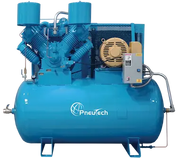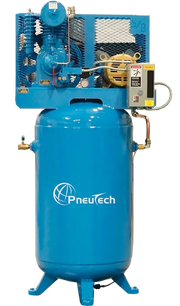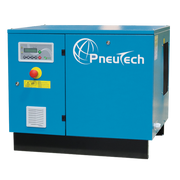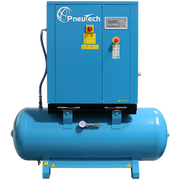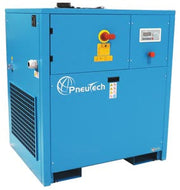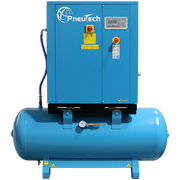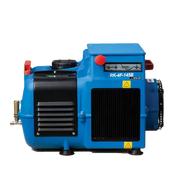

Air Compressors
About Our Air Compressors
Compressed air is everywhere in modern manufacturing, processing, packaging, bottling, plastic molding, and any operation that is reliant on clean, reliable, efficient, and dry compressed air. Fluid-Aire Dynamics specializes in system design, equipment sales, installation, and long term service of compressed air and vacuum systems that serve industrial and commercial operations. We focus on our core service markets of Chicago, Milwaukee, Minneapolis, Detroit, and San Antonio.
Our primary area of expertise is in oil flooded, electric, stationary rotary screw compressors, but we also offer oil-free, rotary vane, and piston/reciprocal compressors when the application and project specifications call for these technologies.
Our Sales Engineering Team will walk you through the process of determining the right size and capabilities that your application demands from your compressed air system. Fluid-Aire Dynamics has a passion for compressed air done right!
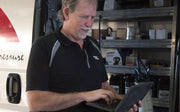
Get in Touch Today
We are here to serve your compressed air system needs 24/7/365. Call or click today!
FAQ
Which is better: a reciprocating (piston-style) or rotary screw air compressor?
Both reciprocating (piston-style) and rotary screw air compressors can deliver a reliable supply of compressed air, but there are important differences.
- Oil-flooded rotary screw air compressors are the most commonly used type of air compressor for industrial applications. Compared to piston-style air compressors, they are quieter, more energy efficient and deliver a higher CFM per horsepower. They also operate at lower temperatures and produce cleaner air with less oil carryover. Most importantly, a rotary screw air compressor operates at a 100% duty cycle. That means they can produce air continuously for operations requiring a constant supply of air 24/7. A rotary screw air compressor can last a long time, too–up to 60,000 to 80,000 hours of use before requiring a rebuild. While they are more expensive up front, they have lower life cycle costs when you factor in their longer lifespan and lower energy use.
- Piston-style air compressors cost less up front and are simpler to maintain. They are also less finicky about the operating environment, performing well even in very dirty environments. Reciprocating air compressors are not designed for continuous use; they typically have a duty cycle between 30%-70%, meaning they are only making air for 30%-70% of the time.
The biggest consideration in deciding between a rotary screw and reciprocating air compressor is how you are using your air. Rotary screw air compressors are designed for continuous use and do not perform well if air use is intermittent. If your air demand is variable but does not drop to zero while the compressor is powered on, a variable speed drive (VSD) motor will allow the compressor to ramp HP up or down in response to demand. Rotary screw compressors (or their cousins, rotary vane air compressors) are an excellent choice for robotic manufacturing, pneumatic conveyor systems, and other applications requiring constant air. If your applications are highly intermittent–e.g., blow off, occasional manual tool use, stop-and-start applications–a piston-style compressor may be the better choice.
Read our complete guide to rotary screw air compressors and contact us for help with compressed air equipment selection.
Do I need a variable speed drive (VSD) air compressor?
Variable speed drive (VSD) rotary screw air compressors have the ability to ramp the speed of the motor up or down to vary the amount of air they are producing. Unlike fixed-speed air compressors, which always make air at their maximum rate, a VSD air compressor can adjust CFM in response to real-time demand. If your air demand is variable, this can result in significant energy savings, because you are only producing as much air as you need.
A VSD motor provides the most benefit if your air demand varies significantly over the course of a shift, day, week or season. If your applications require constant airflow 24/7/365, you will not see much savings from a VSD air compressor. Learn more about VSD air compressors.
If you are considering upgrading to a VSD air compressor, your energy company may help pay for it. Contact us to learn how.
How do I size an air compressor?
Air compressor sizing includes three related components: horsepower (HP), airflow (in cubic feet per minute, of CFM) and pressure (in pounds per square inch, or PSI).
- HP is the basic unit of air compressor sizing. Industrial air compressors come in sizes as small as 4 HP and as large as 350 HP or more. In general, the larger the HP, the more air the compressor can produce.
- CFM tells you how much compressed air the unit can produce. The CFM rating is given for a specific PSI (usually 100 PSI). If your air compressor is rated for 100 CFM at 100 PSI, it means that it can create 100 cubic feet of air per minute while maintaining this pressure. The higher your CFM, the more work your system can do at this pressure.
- PSI is related to CFM. If CFM goes down, PSI goes down, too. Most air powered tools and processes require air between 90-100 PSI. The lower the plant PSI, the less air the compressor will need to make to maintain it.
To determine the size of air compressor you will need, you first need to determine the pressure requirements for your applications and how much air you are using at that pressure.
- First, determine your PSI requirements. You want to make sure pressure does not drop below the minimum ratings for your tools and processes, even those at the end of your piping runs. On the other hand, there is little or no benefit to maintaining pressure higher than the minimum needed. Many plants can save CFM (and energy costs) by reducing plant pressure.
- Next, determine your CFM demand at this pressure. Your air compressor should be rated to meet your peak demand. You can estimate CFM requirements by calculating the max demand for all of the tools and processes that will be running concurrently. Or, for existing plants, you can use data logging or a pump-up timing test to determine actual usage.
- Your compressor should be sized just a little over your peak demand. A compressor larger than you need will simply waste energy and money. If your demand is characterized by infrequent short, intense bursts, an air receiver tank can help you meet these demand spikes without oversizing your compressor. If your demand is highly variable, you may want to consider a variable speed drive (VSD) compressor.
Not sure what size air compressor you need? Fluid-Aire Dynamics can help you size your compressed air system for maximum energy efficiency and reliability.


